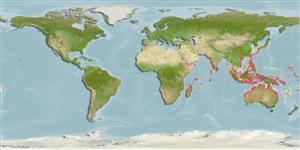Common names from other countries
Environment: milieu / climate zone / depth range / distribution range
Sinh thái học
Biển Cùng sống ở rạn san hô; không di cư; Mức độ sâu 1 - 15 m (Ref. 90102). Tropical; 22°C - 27°C (Ref. 130643)
Indo-West Pacific: Red Sea and southern Oman south to Natal, South Africa and east to the western Pacific where it occurs from Japan to northern Australia.
Bộ gần gũi / Khối lượng (Trọng lượng) / Age
Maturity: Lm ? range ? - ? cm
Max length : 9.0 cm TL con đực/không giới tính; (Ref. 4329)
Các tia vây lưng cứng (tổng cộng) : 8; Các vây lưng mềm (tổng cộng) : 9; Tia cứng vây hậu môn: 2; Tia mềm vây hậu môn: 8. Characterized by having dorsal fin rays VII-I, 9; anal fin rays II,8; pectoral fin rays 16; pelvic fin rays I, 5; pored lateral line scales 23-24; predorsal scales 3; circumpeduncular scales 12 (Ref. 93839); coppery brown to yellowish with an oblique black line below eye; may have three faint, dusky bars on sides (Ref. 2334, 48635); characterized further by the following: irregular whitish bar across anterior caudal peduncle; lower gill cover with dark brown patch; narrow, oblique dark band below eye; yellowish fins; first dorsal fin with dark brown tip; greatest depth of body 2.5-2.8 in SL (Ref. 90102).
Found in shallow protected coastal reef crests and lagoons, hiding below corals during the day, but also trawled on soft bottom (Ref. 48635); also under boulders on shallow reef flats. Nocturnal species. Aquarium breeding is possible (Ref. 130643).
Life cycle and mating behavior
Maturities | Sự tái sinh sản | Spawnings | Egg(s) | Fecundities | Ấu trùng
Mouthbrooders (Ref. 240). Distinct pairing during courtship and spawning (Ref. 205).
Randall, J.E., G.R. Allen and R.C. Steene, 1990. Fishes of the Great Barrier Reef and Coral Sea. University of Hawaii Press, Honolulu, Hawaii. 506 p. (Ref. 2334)
IUCN Red List Status (Ref. 130435)
CITES (Ref. 128078)
Not Evaluated
Threat to humans
Harmless
Human uses
Các nghề cá: Tính thương mại; Bể nuôi cá: Tính thương mại
Các công cụ
Special reports
Download XML
Các nguồn internet
Estimates based on models
Preferred temperature (Ref.
115969): 24.6 - 29.3, mean 28.3 (based on 2805 cells).
Phylogenetic diversity index (Ref.
82804): PD
50 = 0.5000 [Uniqueness, from 0.5 = low to 2.0 = high].
Bayesian length-weight: a=0.01778 (0.00980 - 0.03226), b=3.17 (3.01 - 3.33), in cm Total Length, based on LWR estimates for this species & (Sub)family-body (Ref.
93245).
Mức dinh dưỡng (Ref.
69278): 3.4 ±0.5 se; based on size and trophs of closest relatives
Thích nghi nhanh (Ref.
120179): Chiêù cao, thời gian nhân đôi của chủng quần tối thiểu là dưới 15 tháng (Preliminary K or Fecundity.).
Fishing Vulnerability (Ref.
59153): Low vulnerability (10 of 100).
